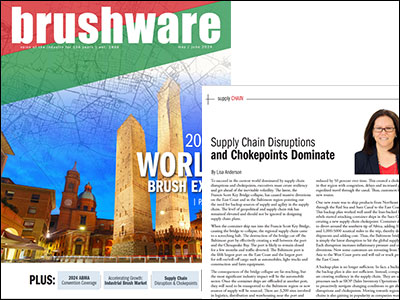To succeed in the current world dominated by supply chain disruptions and chokepoints, executives must create resiliency and get ahead of the inevitable volatility. The latest Francis Scott Key Bridge collapse has caused massive diversions on the East Coast and in the Baltimore region and points out the need for backup sources of supply and agility in the supply chain. The level of geopolitical and supply chain risk has remained elevated and should not be ignored in designing supply chain plans.
When the container ship ran into the Fracis Scott Key Bridge, causing the bridge to collapse, the regional supply chain came to a screeching halt. The collapse of the bridge cut off the Baltimore port by in essence setting up a wall between the port and the Chesapeake Bay, thereby shutting down the port. The port is likely to remain closed for a few months and traffic diverted. The Baltimore port is the 5th largest port on the East Coast and the largest port for roll-on/ roll-off cargo such as automobiles, light trucks, and construction and farm equipment.
The impacts of the Baltimore bridge collapse are far-reaching. The most significant industry impact will be on the automobile sector. Once the container ships are offloaded at another port, they will need to be transported to the Baltimore region or new sources of supply will be sourced. There are 3,200 sites involved in logistics, distribution and warehousing nearby the port and bridge. According to the American Trucking Associations (AMA), almost 4,900 trucks travel the bridge each day, with $28 billion in goods crossing each year. Severe disruption will remain until the bridge is rebuilt, creating congestion and diversions for the next few months.
The Baltimore bridge collapse is just the latest in a series of disruptions and chokepoints in the global supply chain. The pandemic created a significant chokepoint at the West Coast ports. According to the Journal of Commerce, the West Coast share of imports coming from Asia was down from 61.1% in 2021 to 58.8% in 2022 while the East Coast and Gulf Coast ports rose. For example, customers started diverting shipments from Northeast Asia destined for the East Coast through the Panama Canal; however, in 2023, the Panama Canal experienced a drought and capacity was reduced by 50% over time. This created a chokepoint in the region with congestion, delays, and increased prices for expedited travel through the canal. Thus, customers looked for new routes.
One new route was to ship products from Northeast Asia through the Red Sea and Suez Canal to the East Coast ports. This backup plan worked well until the Iran-backed Houthi rebels started attacking container ships in the Suez Canal. This created a supply chain chokepoint. Container ships had to divert around the southern tip of Africa, adding 10 days and 5000-1000 nautical miles to the trip, thereby delaying shipments, and adding cost. Thus, the Baltimore bridge collapse is simply the latest disruption to hit the global supply chain. Each disruption increases inflationary pressure and creates new diversions. In fact, some customers are rerouting from Northeast Asia to the West Coast ports and will rail or truck products to the East Coast.
A backup plan is no longer sufficient. In fact, a backup to the backup plan is also not sufficient. Instead, companies are creating resiliency in the supply chain. They are uses processes such as SIOP (Sales Inventory Operations Planning) to proactively navigate changing conditions to get ahead of disruptions and chokepoints. Moving towards regional supply chains is also gaining in popularity as companies want to gain control over their supply chain. Advanced technologies such as 3D printing also provides additional options for gaining control and creating resiliency. Being vulnerable to disruptions is no longer an option.



